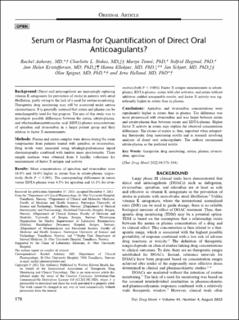| dc.contributor.author | Aakerøy, Rachel | |
| dc.contributor.author | Stokes, Charlotte Lorentze | |
| dc.contributor.author | Tomic, Marija | |
| dc.contributor.author | Hegstad, Solfrid | |
| dc.contributor.author | Kristoffersen, Ann-Helen | |
| dc.contributor.author | Ellekjær, Hanne | |
| dc.contributor.author | Schjøtt, Jan Didrik | |
| dc.contributor.author | Spigset, Olav | |
| dc.contributor.author | Helland, Arne | |
| dc.date.accessioned | 2023-01-17T12:16:20Z | |
| dc.date.available | 2023-01-17T12:16:20Z | |
| dc.date.created | 2022-01-25T21:41:56Z | |
| dc.date.issued | 2022 | |
| dc.identifier.citation | Therapeutic Drug Monitoring. 2022, 44 (4), 578-584. | en_US |
| dc.identifier.issn | 0163-4356 | |
| dc.identifier.uri | https://hdl.handle.net/11250/3044008 | |
| dc.description.abstract | Background:
Direct oral anticoagulants are increasingly replacing vitamin K antagonists for prevention of stroke in patients with atrial fibrillation, partly owing to the lack of a need for routine monitoring. Therapeutic drug monitoring may still be warranted under certain circumstances. It is generally assumed that serum and plasma can be interchangeably used for this purpose. The aim of this study was to investigate possible differences between the serum, citrate-plasma, and ethylenediaminetetraacetic acid (EDTA)-plasma concentrations of apixaban and rivaroxaban in a larger patient group and their relation to factor X measurements.
Methods:
Plasma and serum samples were drawn during the same venipuncture from patients treated with apixaban or rivaroxaban. Drug levels were measured using ultrahigh-performance liquid chromatography combined with tandem mass spectrometry. Three sample matrices were obtained from 8 healthy volunteers for measurement of factor X antigen and activity.
Results:
Mean concentrations of apixaban and rivaroxaban were 16.8% and 36.6% higher in serum than in citrate-plasma, respectively (both P < 0.001). The corresponding differences in serum versus EDTA-plasma were 4.5% for apixaban and 13.1% for rivaroxaban (both P < 0.001). Factor X antigen measurements in citrate-plasma, EDTA-plasma, serum with clot activator, and serum without additives yielded comparable results, and factor X activity was significantly higher in serum than in plasma.
Conclusions:
Apixaban and rivaroxaban concentrations were significantly higher in serum than in plasma. The difference was more pronounced with rivaroxaban and was larger between serum and citrate-plasma than between serum and EDTA-plasma. Higher factor X activity in serum may explain the observed concentration differences. The choice of matrix is, thus, important when interpreting therapeutic drug monitoring results and in research involving analyses of direct oral anticoagulants. The authors recommend citrate-plasma as the preferred matrix. | en_US |
| dc.language.iso | eng | en_US |
| dc.publisher | Lippincott, Williams & Wilkins | en_US |
| dc.rights | Attribution-NonCommercial-NoDerivatives 4.0 Internasjonal | * |
| dc.rights.uri | http://creativecommons.org/licenses/by-nc-nd/4.0/deed.no | * |
| dc.title | Serum or Plasma for Quantification of Direct Oral Anticoagulants? | en_US |
| dc.title.alternative | Serum or Plasma for Quantification of Direct Oral Anticoagulants? | en_US |
| dc.type | Peer reviewed | en_US |
| dc.type | Journal article | en_US |
| dc.description.version | publishedVersion | en_US |
| dc.source.pagenumber | 578-584 | en_US |
| dc.source.volume | 44 | en_US |
| dc.source.journal | Therapeutic Drug Monitoring | en_US |
| dc.source.issue | 4 | en_US |
| dc.identifier.doi | 10.1097/FTD.0000000000000956 | |
| dc.identifier.cristin | 1989953 | |
| cristin.ispublished | true | |
| cristin.fulltext | original | |
| cristin.qualitycode | 2 | |

